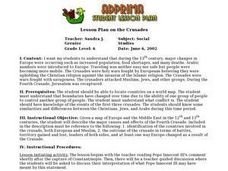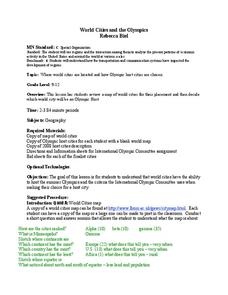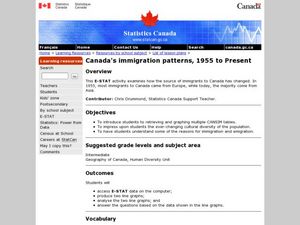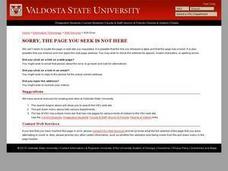Curated OER
HIV/AIDS And Contemporary Population Dynamics
Students describe the spread and occurence of HIV/AIDS at multiple scales. They explain global and regional variations in the occurence of HIV/AIDS and explain the spread of HIV/AIDS in the United States.
Curated OER
Deportation and Loss
Seventh graders discuss the issues of isolation and deportation as they are related to the Holocaust. After reading a brief passage about deportation and confinement in a concentration camp, 7th graders discuss the feelings involved in...
Curated OER
Out With the Old, in With the New
Students engage in a lesson that is concerned with the concept of the Soviet Union and compared to the new Democratic Russia. They conduct research using a variety of resources. The information is used in order to create a class project.
Curated OER
"ART ZOO 'Blacks in the Westward Movement', 'What Can You Do with a Portrait', and 'Of Beetles, Worms, and Leaves of Grass'"
Students study black history, examine portraits and portrait making and create their own portraits, and investigate their natural environment. This humanities lesson provides a text that can be used to teach lessons in black...
Curated OER
Finding Historical Evidence: David Brion Davis
Students study the Tran-Atlantic Slave Trade and learn to evaluate historical arguments. In this slave trade lesson, students read about the Atlantic Slave System. Students take notes on slave trade and make a timeline for the...
Curated OER
Traveling Through North America
Students identify places and landmarks in North America, specifically Canada and the United States, by using and constructing maps. Six lessons on one page; includes test.
Curated OER
The Chernobyl Accident
Fifth graders see that the Chernobyl Accident of 1986 was caused by a poorly developed experiment in a nuclear power plant. They explain the purpose of a nuclear power plant and determine the health effects that radioactivity causes.
Curated OER
Immigration in Canada and in the European Union
Twelfth graders explore immigration policies. In this immigration lesson, 12th graders discuss the implications of immigration as they read polices for Canadian and European Union immigration. Students then draft their own immigration...
Curated OER
Traveling the Silk Road
Students take a virtual trip down the Silk Road. Using a map, they trace the location of the trade route and others that were developed later. They use different spices and goods to trace how they came to the Americas. They answer...
Curated OER
World War II Review
Ninth graders review previously presented material on World War II and discover how the world was at that time. They, in groups, participate in map work designed to explain Axis and Allied countries using toy army men.
Curated OER
Views of the American West: True or False?
Students explain that a landscape painting may or may not accurately represent a specific place. They identify techniques that create the illusion of three-dimensional space on a flat surface.
Curated OER
World Cities and the Olympics
Students examine the various cities in which Olympics have been held. Using a map, they describe the reasons why those cities were chosen and choose their own city for the Olympics and state the reasons why. They examine information...
Curated OER
The Mausoleum at Halicarnassus
Students explore an ancient wonder of the world. In this Mausoleum at Halicarnassus lesson, students read about the history of the Mausoleum, create Mausoleum timelines, and research the sculptors whose work is featured in the Mausoleum.
Curated OER
We Are Colony! Settlement Design
Pupils explore government systems. In this colonial America lesson, students consider colonial settlement needs as they design settlements that can sustain themselves and meet the needs of colonists.
Curated OER
Mapping Population Changes In The United States
Students create a choropleth map to illustrate the population growth rate of the United States. They explore how to construct a choropleth map, and discuss the impact of population changes for the future.
Curated OER
JAPAN, IMAGES A PEOPLE
Students interpret Japanese and American paintings; evaluate paintings as sources of cultural and historical information
Curated OER
Canada's Immigration patterns: 1950 to Present
Students examine the changing immigration pattern of Canada. In this immigration lesson, students use statistical data from a web-site to complete a worksheet and graph their findings.
Curated OER
Ponce de Leon
Fifth graders explain that the discoveries of Ponce de Leon were important, both in and of themselves and to the destinies of Europeans and Native Americans. They write an essay highlighting two of his important discoveries.
Curated OER
Colonies and Revolution: Comparing US and Mexican History
Students examine the emergence of the United States and Mexico as independent nations. They compare the colonial history of the two countries and discover the emergence of social classes.
Curated OER
Killing Fields
Students view a television program that explores people's perceptions and expectations in war prior to and after WWI. They discuss the effects of trench warfare and write a journal entry or short oral report reflecting on their...
Curated OER
The European Union
Seventh graders perform research related to the concept of the European Union. By becoming familiar with the Union they comprehend the advantages and disadvantages of the governmental structure.
Curated OER
The Russian View of Territorial Encroachment
Twelfth graders produce a map illustrating the current NATO members, future nations, and nations that have applied for membership. They research current information regarding NATO, and the Russian viewpoint about the expansion of NATO....

























